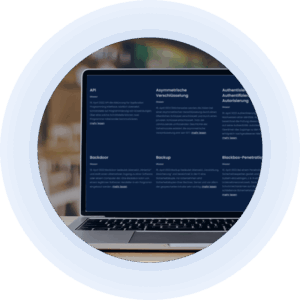
Kriminelle versuchen mit Hilfe von betrügerischen E-Mails, gefälschten Internetseiten und anderen Methoden an vertrauliche Unternehmensdaten zu gelangen. Indem die Betrüger vorgeben, eine bekannte Person (Kollegin, Chef) oder Organisation (Bank, Dienstleister) zu sein, nutzen sie das Vertrauen des Opfers aus, damit es Informationen bereitwillig preisgibt.
Der Arbeitstag beginnt und Sie rufen Ihre E-Mails ab, dann entdecken Sie eine E-Mail von einem Ihrer Dienstleister. Im Text ist von einer Rechnung die Rede, deren Höhe Sie überrascht. Die Rechnung ist als Dokument angehängt. Sie wundern sich, da Sie diesen Dienstleister in den letzten Monaten gar nicht beauftragt haben. Was Sie in den nächsten Sekunden tun, ist entscheidend:
A) Sie behandeln diese E-Mail mit Skepsis, denn Sie sind sich sicher, dass keine Rechnung von diesem Dienstleister zu erwarten war. Sie schauen sich die E-Mail noch einmal genau an. Als Absender ist zwar Ihr Dienstleister angegeben, aber die E-Mail-Adresse ist auffällig. Sie lautet z. B. web@YSJ1QFWP8RU0C0N6.net oder bricklayer316@moselland.de. Ihr Misstrauen vertieft sich und Sie löschen diese E-Mail. Falls Sie sich unsicher sind, rufen Sie Ihren Dienstleister kurz an. Auf keinen Fall öffnen Sie den Anhang dieser E-Mail, so lange Sie nicht vollkommen sicher sind, dass er wirklich von Ihrem Dienstleister stammt.
B) Sie öffnen den Anhang der E-Mail, um Genaueres zu erfahren. Es passiert anscheinend nichts Schlimmes, allerdings ist die Rechnung offensichtlich fingiert. Sie löschen die E-Mail. Doch beim Öffnen des Anhangs hat sich bereits ein Virus aktiviert. Während Sie sich anderen Dingen widmen, versendet er in Ihrem Namen E-Mails mit falschen Rechnungen an all Ihre Kontakte. Wenn Sie Pech haben, lädt der Virus danach Schadprogramme auf Ihren Computer, die zu Ausfällen oder sogar Erpressungen führt.
Begegnen Sie E-Mail-Anhängen und Links grundsätzlich mit Misstrauen. Kontrollieren Sie bei E-Mails immer die E-Mail-Adresse des Absenders. Offensichtliche Fälschungen löschen Sie. Aber auch beim geringsten Verdacht ignorieren Sie die E-Mail zunächst und überprüfen sie außerhalb des E-Mail-Programms:
Weitere Informationen finden Sie im Informationsbereich der Verbraucherzentrale rund um E-Mail-Spam, Phishing und Trojaner: www.verbraucherzentrale.de/wissen/digitale-welt/phishingradar
Criminals use fraudulent emails, fake websites and other methods to gain access to confidential company data. By pretending to be a known person (colleague, boss) or organisation (bank, service provider), they exploit the victim’s trust so that they willingly disclose information.
The working day begins and you check your emails, then you discover an email from one of your service providers. The text mentions an invoice, the amount of which surprises you. The invoice is attached as a document. You are surprised because you have not commissioned this service provider in recent months. What you do in the next few seconds is crucial:
A) You treat this email with scepticism because you are sure that you were not expecting an invoice from this service provider. You take another close look at the email. Although your service provider is listed as the sender, the email address is suspicious. For example, it reads web@YSJ1QFWP8RU0C0N6.net or bricklayer316@moselland.de. Your suspicion deepens and you delete the email. If you are unsure, give your service provider a quick call. Do not open the attachment in this email under any circumstances until you are absolutely certain that it really comes from your service provider.
B) You open the attachment in the email to find out more. Nothing bad seems to happen, but the invoice is obviously fake. You delete the email. However, a virus has already been activated when you opened the attachment. While you are busy doing other things, it sends emails with fake invoices to all your contacts in your name. If you are unlucky, the virus will then download malicious programs onto your computer, which can lead to system failures or even extortion.
Always treat email attachments and links with suspicion. Always check the sender’s email address in emails. Delete obvious fakes. But even if you have the slightest suspicion, ignore the email at first and check it outside your email programme:
Further information can be found in the information section of the Consumer Advice Centre on email spam, phishing and Trojans: www.verbraucherzentrale.de/wissen/digitale-welt/phishingradar